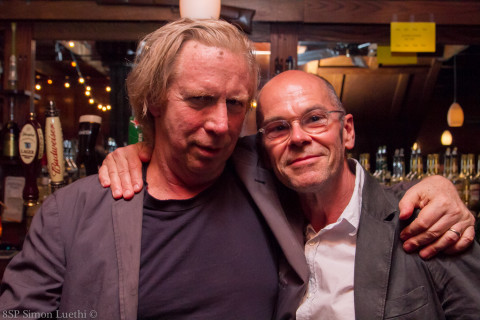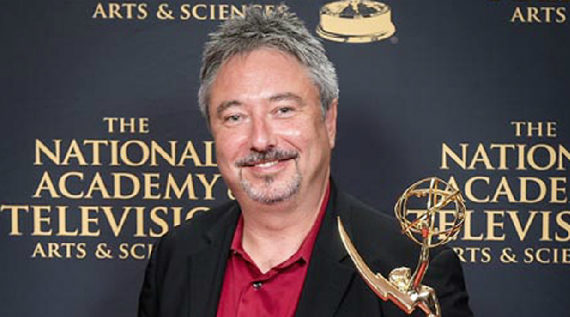
Friends and fellow filmmakers, Kevin Rafferty and Robert Stone, catch up after PANDORA'S PROMISE. Photo by Simon Luethi.
Changing one’s strongly-held personal and political beliefs is never an easy decision, but what do you do when you realize that you have no other choice? This is the question with which the subjects of Robert Stone’s Pandora’s Promise grapple. The film profiles a group of environmentalists who have made the transition from being anti-nuclear crusaders to being pro-nuclear supporters, as they agree that nuclear power is the only way to change the current effects of climate change. Stone presents scientific evidence to support the activists’ claims, while also exploring the challenges and struggles experienced by individuals who go against the status quo in order to defend their true beliefs. Pandora’s Promise is a bold look into the future of environmentalism and fearlessly poses questions that are critical to address in the battle to preserve Earth.
Stone joined STF’s Thom Powers for a post-screening Q&A, featuring contributions from surprise guests in the audience.
Stranger Than Fiction: Robert, your very first film, a few decades ago, was Radio Bikini, about the atomic bomb. You’ve made other films about the environmental movement. Can you talk about your own process of thinking around this subject?
Robert Stone: It’s been a long journey. The inspiration to make this film was in the people in this film. Their personal journeys on this really mirror my own in a great many ways. I was never an activist like they were, so I wasn’t protesting and marching against power plants or anything like that, but I very much came out of the whole anti-nuclear thing and have been an environmentalist my whole life. The first time I ever picked up a camera was to do a little film for my seventh grade science class on the first Earth Day. This is in my blood.
I’ll just tell you a little bit about the spark for this film. I made a film called Earth Days, which was a history of the environmental movement. It was a closing night film at Sundance in ’09. It played the Eccles Theatre; like 1500 people were there, and it was a big thing. I came out and started doing the Q&A, and somebody in the front row raised their hand and asked me what my position on nuclear power was. Like, totally out of the blue. I said that my position had evolved, but I wanted to bring out Stewart Brand who’s also in that movie, because Stewart has a lot of interesting things to say. He came out, and he made a five-minute really impassioned plea for nuclear power from an environmental perspective, after everyone had seen this movie just revering him as an environmental legend, which he is. And the place just went nuts. I had never seen anything like it. It was insane. Like, nobody wanted to talk about Earth Days anymore; it’s like, “Let’s talk about nuclear power.” It wasn’t in a bad way – they were just fascinated.
I’d already come around on this from reading Stewart’s book, and I’d talk about it with people. When I’d go to dinner parties, people would ask me, like they always do, “What are you working on?” Usually that’s a two-minute conversation; this topic became the topic of the dinner party. Nuclear power. (laughter) So there’s something special. It’s the elephant in the room. I think this is the elephant in the room about a whole host of environmental issues and climate change and, really, once you get your head around it, kind of reorients your thinking.
STF: I want to ask you about Helen Caldicott, who, for a long time, has been a revered figure of the Left. I wonder what your perspective on her is.
Stone: Well, she was revered for me, too. She did amazing things in her campaign against nuclear weapons. I think where she’s gone off the rails is that she completely, completely conflates nuclear weapons with nuclear power, to the point where she sees it as an absolute abomination, just like Right to Life zealots see abortion. There’s no equivocation; it’s just evil and must be eradicated from the Earth in every possible way, and she’ll say or do anything to achieve that. It’s kind of sad, because she had a really positive impact, once upon a time.
Audience: I have a question about radiation. I lived in a place where atomic bombs were dropped, and there was always talk about how there was increased radiation there and increased cancer risk. So I’m wondering if there’s any doubt that radiation causes cancer.
Stone: No. There’s no doubt. Radiation, above a certain level, will cause cancer. Below a certain level, it apparently doesn’t cause cancer. It’s really what that level is. If you sit out in the sun, you’re getting radiation from the sun, and you’re going to get melanoma. The point is, at what level?
The levels that we’re talking about in relation to nuclear energy are so low, they don’t even rise above, for the most part, the variations that we get in natural background radiation in various parts of the world. That’s why I went around the world with a Geiger counter, so I could show the relative risk, that’s never, ever portrayed in the news. It’s always just this absolute thing – this thing’s just beeping, and it’s terrible. (laughter)
Audience: As an ex-science major in college, I really loved this film, but since this film’s message so goes against the “mainstream” message, what’s your experience dealing with distribution? Are there a lot of broadcasters signing on to broadcast this?
Stone: Well, we’ll see, won’t we? I’ve been told for four years that nobody will ever go see this movie, ’cause there’s no audience for this movie. I don’t believe that, and it remains to be seen. We’re going out pretty wide in movie theaters around the country. We’re opening in New York on June 12 at the Sunshine, going into 25 cities on June 14, and heading out from there. CNN Films has picked it up for national broadcast in November, and then we’re going into 25 countries on iTunes in December. So we’re going wide. I’ve been doing a college tour around the country, zipping around, and the response has been overwhelmingly positive. People are really digging it.
Most of the environmental films – and I’ve made a couple myself – are very depressing. They’re trying to raise a level of alarm for the general public to wake up to the problem of climate change, which is extremely real and was what motivated me to make this film. Where we get into trouble is when we discuss the solutions to climate change. What I’ve tried to do with this film is make a hopeful film that has an actual solution that is viable and something that we can implement now to reduce CO2 emissions within the next few decades. I know there are a lot of questions about “Should the world look like it does in that last shot? Should we use so much energy?” Well, we are going to use that much energy. “Should population be so high?” I don’t want to live in a world of nine billion people, but it’s going happen.
Audience: I was captivated by the image of the Shoreham control room, and there was the coffee cup. Was that really there?
Stone: That was really there. It was not staged. Gwyneth Cravens is right here, and she was with me! (laughter) Raise your hand, Gwyneth.
Gwyneth Cravens: He’s telling the truth. (laughter) There was garbage in the place and an old coffee cup and rusty things…
Stone: …old 1970s phone books.
Cravens: Yeah. It was like going into a tomb. (laughter)
Stone: Yeah. Nothing was staged, not even the bananas.
Audience: I’d just like to say that it’s nice to look into the future and to have this nice clean fantasy, but we have 400 power plants from the old world that we have to deal with. But that’s not the question. (laughter) What happened at Yucca Mountain? I wanted to see what’s inside there. What happened?
Stone: Nothing’s inside there. What happened was the federal government is, by law, obligated to take care of all the nuclear waste and provide a repository for that. There’s been a political hold up in doing that, I think in part because a lot of people who are against nuclear power really don’t want to see a solution to this, because if there was a solution to the nuclear waste problem, it would take away one of the biggest arguments against nuclear power. So there’s been a lot of opposition to ever using this place as a repository. Also, a lot of that comes from the idea that we have to store this stuff for 100,000 years, and who can project what a location is going to be like for 100,000 years? But I think that what’s been pointed out in this film is that this stuff isn’t waste, it’s fuel. It’s fuel for the next generation of plants. So we’re going to use this stuff for the next generation and we’re probably only going to need to store this stuff for a few hundred years, which is a totally doable thing. But we do need to take it somewhere and stop leaving it in pools and other dry-cast storage and move it somewhere.
One thing I would point out: you know the image of the football field of all the nuclear waste in the United States? That material could power everything in the United States – transportation, absolutely everything – for 1,000 years. In the United States. Would power the United States for 1,000 years, just that material, without ever mining a gram of uranium ever again. Great Britain has enough to power their whole country for 500 years. So this stuff is not waste, it’s fuel, and it should not actually be buried for 100,000 years.
Audience: But couldn’t a nuclear plant become a nuclear weapon? I mean, in a war, in acts of terrorism, in acts of sabotage, natural disasters?
Stone: That’s a great question. Can a nuclear power plant become a nuclear weapon? It’s actually a very different process. A nuclear weapon is 90% pure uranium and is contained. The whole process is to contain this very volatile material. A nuclear reactor is the opposite. It’s 3% pure, and the purpose is to expand. It’s an open system; it’s not compressed. So a nuclear power plant cannot blow up. Chernobyl blew up from a steam explosion; Fukushima blew up because of a hydrogen explosion. These were not nuclear explosions. So, in effect, no, a nuclear power plant can’t become a nuclear weapon.
And in terms of using a nuclear power plant to make a nuclear weapon, no country in the world has ever actually done that. India kind of did it with an experimental reactor that was given by the Canadians back in the ’50s as part of the whole Atoms for Peace thing, but really, all you have to do is look at Iran. Iran has a nuclear power plant, Bushehr Nuclear Power Plant, but how are they trying to make their weapon? They’re taking raw uranium and spinning it in centrifuges, because the material in the reactor is not useful to them to make a bomb. So they are very different things, but, you know, as is stated in the film, if you know how to make a nuclear reactor, you will definitely have the knowledge to make a nuclear bomb. But that knowledge is already out there, widely available around the world.
STF: Someone earlier asked about growing up near a site that felt like it had a lot of radiation around it, and certainly there’s a lot of anecdotal feeling that in areas around nuclear reactors, people believe there are higher rates of cancer. That’s said about areas of Long Island; we showed a film here last year, The Atomic States of America, which had a lot of credible people advancing arguments like that. What is your take on those kinds of beliefs?
Stone: Well, I don’t know. I have no independent determination whether any of this is true. And neither do you and neither does anybody. We’re not scientists. The only way you can figure this stuff out is by relying on peer-reviewed consensus and scientific research, where they’ve done large-scale epidemiological studies and figured out whether the cancer rate is elevated over here versus over there. They’ve done that with Chernobyl, and the conclusions are rather surprising. You’re not going to get it by walking down the street and saying, “Hey, do you have cancer?” 20% of us die of cancer and 30% of us will get cancer. That’s a statistic that’s shocking and most of us don’t want to think about. We want to think that there’s some reason for that.
So it’s only natural that if there’s a power plant down the road or something that you might attribute to causing that, you’re going to say, “Well, that caused it.” Making a film about that and interviewing people…I find it exploitative and unhelpful. It’s exactly what the news media does all the time. Fear sells. It’s always about that, because it’s an emotional thing. We’re hardwired to react to things that scare us. We’re not hardwired to react to things that don’t scare us.
Kevin Rafferty: Hey, Thom.
STF: Yeah. Kevin Rafferty…
Stone: Kevin Rafferty! Who made Atomic Cafe!
STF: …at the same time Robert was making Radio Bikini, yeah?
Stone: No, I wouldn’t have been able to make Radio Bikini if it wasn’t for Kevin Rafferty. (laughter)
Rafferty: You mentioned an elephant in the room. And to me, the elephant in the room of this whole issue is bad people who want to do bad things to other people. And you didn’t mention that at all in your movie. I mean, the IRA used to kidnap bank managers’ families and try to snip off the little daughter’s fingers unless they gave them all their money!
Stone: Yes? (laughter)
Rafferty: If I wanted to do something bad, let’s say to New York City or wherever, there are so many opportunities for this. It’s like a second amendment issue. I mean, you can get a rifle, or you can get a 50-caliber machine gun, or you can get a tank, but can you get a dirty bomb? Does the second amendment cover that? (laughter) There are all these people who want to do bad things, and here’s all this stuff sitting in the parking lot, and it seems to me there are opportunities there for doing bad things.
Stone: Yeah?
Rafferty: You didn’t mention that in your movie. That, to me…
Stone: Well, people are doing…I mean, you and I were both here in New York on 9/11. People are gonna do bad things without necessarily breaking into a nuclear power plant and drilling a whole into a four-foot piece of concrete, through three feet of steel and taking out some piece of radioactive…I mean, if you ever did that, you’d have the entire US Army after you.
The thing that we need to be concerned about is the weapons-grade plutonium that is loose in the world, largely as a result from the collapse of the Soviet Union. And it’s this material – not the stuff that’s sitting in nuclear reactors in the United States or other countries – that we need to be worried about. In fact, as is pointed out in the film, the only way that you can get rid of that stuff, remove it from the face of the Earth is you either bury it underground – which gives you another security problem – or you put it in a faster reactor and you turn it into electricity.
Interestingly, in Great Britain, it looks like they are going to be the first country to have built an IFR. General Electric has commercialized the IFR; they call it the Prism Reactor, and Greenpeace and Friends of the Earth are actually behind this, ’cause they want to get rid of this weapon-grade plutonium, and Britain has the only way to do it. So actually, nuclear power can alleviate some of the concerns that we all have about terrorists getting their hands on this dangerous material.
Terrorists can do all kinds of things. They can plant a pressure cooker. It doesn’t need to be this big, sophisticated thing to cause huge damage. Or they can run a plane into the Hoover Dam. What are you going to do? You end up like Dick Cheney, living in a cave, if you just go on with that kind of thinking.
Audience: I don’t know if you really answered Kevin’s question, so let me ask it another way. What would be the impact of a terrorist attack on Indian Point?
Stone: I can tell you exactly that. Sandia Labs has actually done a test where they ran a jet into the reinforcement cement wall, which is exactly the same as a containment dome. And what happened was – I’m gonna put it on the website; I actually thought of using it in the film, but I didn’t, since the film could only be 90 minutes and I didn’t have time – what happened was the jet just disintegrated. It penetrated an inch. It penetrated an inch.
Audience: So you’re saying it’s impossible to have a terrorist attack…
Stone: No, I’m not saying that. The danger is if you ran a plane into the spent fuel pool. You could have a problem with that. Why do we have spent fuel pools? One of the reasons we have spent fuel pools around the country is we have not come up with a solution to deal with the waste. And why is that? But that is a problem; I absolutely agree that is a problem.
Audience: So what would be the impact?
Stone: What would be the impact? If a jet ran into Indian Point, you’d get a large release of radiation, which would probably have the same effect that maybe Fukushima had. I don’t know.
But let’s step back, because the question really is: what if we get rid of all the nuclear power around the world, and we never pursue it again? What are the consequences of that? Now, everybody here in New York City just experienced Hurricane Sandy. That cost 50 billion dollars. Suppose that just becomes an annual event, because we’re just spewing CO2 emissions into the atmosphere? CO2 emissions now are higher than they have ever been in all of human history. They are going up in an accelerating rate. We are burning coal in an accelerating rate. 2012 was the hottest year on record. Everything is trending in the wrong direction, and we need to do something very dramatic. So you need to measure that risk, which is quantifiable and scientifically provable, versus an abstract risk of something maybe happening, of which we know sort of what the damage would be.
There’s no perfect solution. There’s no perfect energy source that carries no risk. All of life is a risk. But we are facing an imminent – I believe, from talking to the climate scientists – we are facing an imminent catastrophe, within the lifetime of some of the people in this room. And what we do in the next few decades is going to determine the future of all humanity. It’s about reducing CO2 emissions. What do we have? Nuclear power has amazing potential. Nobody’s talking about building Indian Point again, or Vermont Yankee, or any of those kinds of things. These are totally new, different types of reactors that are fueled by nuclear waste, that are passively safe, that are economically viable – why would you be against that?
Audience: Would you recommend that they extend the licenses of Indian Point, which are now under review?
Stone: Well, depends what the option is. I would like to see an advanced nuclear reactor replace Indian Point. I don’t want to see a gas plant replace Indian Point. I live up in the Catskills; hydrofracking is not something I’m in favor of. I don’t want to see a coal plant. You’re not going to put up a few wind turbines or solar panels to replace, I think it’s like 1/3 of New York City’s electricity comes from Indian Point? That’s not going to happen. So what are your choices? That’s the thing. I think all the nuclear plants that we have online now should be responsibly, slowly phased out and replaced with advanced designs. That’s what I’d like to see.
Audience: Hi, I’m from Fusion Energy League, and my question relates to what that man asked…
Robert Stone: That’s Kevin Rafferty. He made The Atomic Cafe. He’s a great filmmaker.
Audience: …about the bad guys and, more to the point, conflict of interest. As a fusion promoter, we’re often talking down fission. Because our weakness is, of course, that we don’t work yet, and, of course, you guys do. But that’s just one conflict of interest. I imagine you get that everywhere. And that one line that you pointed out about how solar, not nuclear, was funded by oil, to me was where the real resistance is coming from.
Stone: I’m not sure I get…do you have a question?
Audience: Yes! The question is, where is the most resistance? Where would the power come to transform to nuclear? ‘Cause it seems like the “bad guys” of the film…
Stone: Oh, now I understand your question. The resistance is purely economics, at the moment. It’s not going to happen in the United States. We’re just burning gas and we’re going to burn gas for 30, 40 years. That’s what we’re doing. Gas is cheaper than air. We’re going to burn gas.
Everything that’s exciting in nuclear energy is all happening in China and India and elsewhere in Asia. The Chinese are going gangbusters on nuclear. They’ve got 27 plants that they’re building right now, and they’re experimenting with the very latest designs. In 30 years, we’re going run out of gas or realize that our CO2 emissions are the highest in the world, and we’re gonna be buying nuclear reactors from China. I’m afraid that’s probably where it’s going to go. But that is the resistance. You’ve got to make it economically viable. If it’s not economically viable, it’s not going to happen.
Audience: So the US can’t foresee that, “Oh, we’re gonna run out of this?” Or are they shifting their assets?
Stone: Well, that was the other really amazing discovery in making this film. I’d always heard about the nuclear industry. And there is no nuclear industry. It doesn’t exist. It’s surprising. They’re just big energy companies. They own nuclear reactors, they own coal plants, they own solar arrays, they own wind farms; they own all kinds of shit. And nuclear is just one of them, and they don’t want to promote their nuclear power, because the only reason to promote nuclear is to say, “This can solve climate change,” but then they’re dissing their coal plants, which are making a lot of money as well as their nuclear plants.
So, you know, there’s really nobody to say to support nuclear power. Except environmentalists, I think, who really ought to take a look at this as a viable solution. We’ve been trying wind and solar for 30 years. We’ve been trying international treaties for 30 years. At 350.org now, they want to just turn off the spigot, divest in the fossil fuel plants and turn off the Keystone XL, but I don’t see anyone turning in their iPhones or shutting off their computers or taking the stairways instead of the elevators. We’re all consuming a lot of energy. And that’s the problem. We’re going consume a lot more of it. Not just here, but mostly in the developing world. And do you want to tell people in the developing world that they shouldn’t have energy? There’s a lot of that going around, too.





